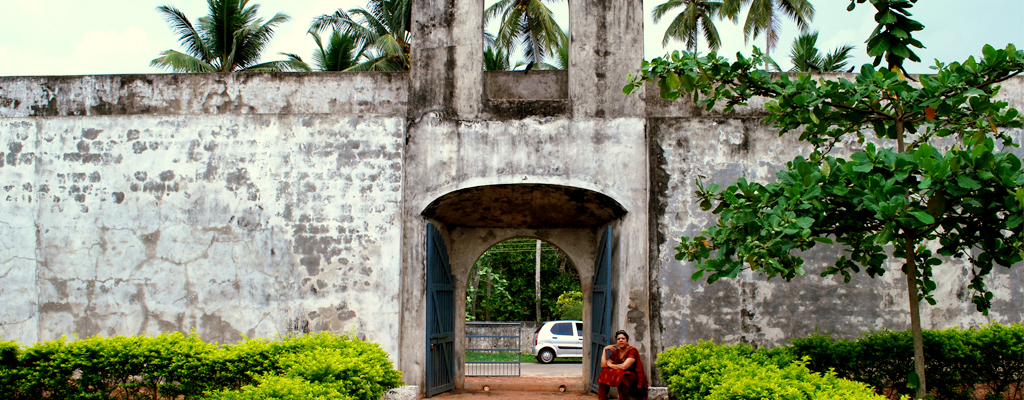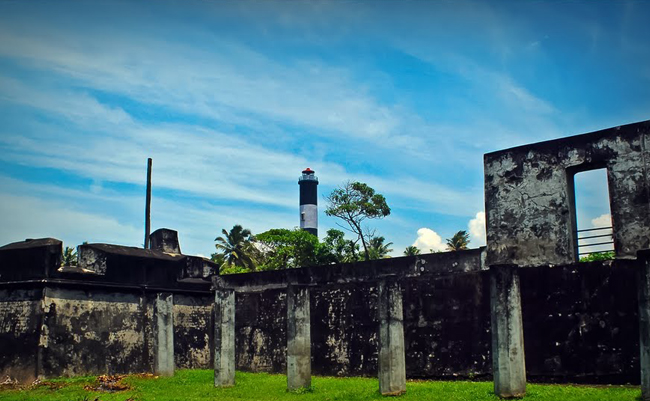For the history buffs and experience seekers I have a place in mind in Trivandrum, The Anjengo Fort. Anchuthengu, formerly known as Anjengo, is a place situated about 12 km from Varkala en route to Kadakkavur. It is another coastal town in Trivandrum district and is known as an old colonial settlement. The island is very small in area, sandwiched between the sea and backwaters, but it has high relevance in the history of India, with various colonial powers. The Portuguese, Dutch and the English tried to occupy the place.
The major landmark at Anchuthengu is Anjengo Fort, which is situated between the sea and backwaters. Travelers can also see some ancient tombstones and a garden on the fort premises. Preserved under the National Heritage monuments, the fort was constructed in 17th century.
Where did the name come ?
Anchuthengu, literally means five coconut trees, and as the name indicates the whole land is cultivated with coconut trees. Some historians are of the view that the name was derived from Anjingal, which was the original Tamil name of the place.
The British mispronounced it as Anjengo and the later generations of the local residents started to refer to this place as Anchuthengu.
History of Anjengo fort
Anchuthengu has great relevance in the history. It was the first trade settlement of the East India Company. The Queen of Attingal gave permission to the British under the East India Company to make a factory in Anchuthengu in 1684.
They also got a permission to build a fort in 1690 and the Anjengo Fort was built in 1695. The settlement in Anchuthengu helped the Company promote its trade with various countries, as the place supported water way communication to the North.
They also opened a depot to keep the military equipment at Anchuthengu. In short, this small island soon became one of the major trading platforms of the British in India, after Mumbai.
There was local unrest against the British in 1697 and the natives attacked the British factory at Anchuthengu, but it was a minor unrest and could create no major ripples in the political equation of the country.
But the Attingal rebellion of 1721 has some historical significance. The natives were very unpleasant due to the arrogant approach of the British towards them and they were further distanced from them due to some new unjust measures that the British tried to implement in the land.
But at the same time the British pleased the Queen with precious gifts. In 1721, the local feudal lords demanded the British to give presents to the Queen of Attingal only through them. The British refused to obey this and with about 140 English traders, they proceeded to Attingal with the gifts for the Queen.
The local people attacked the group and killed all the English traders. They also sieged the Anjengo Fort. The attack was defended by Gunner Inns and later the rebellion was defeated when more British force from Thalassery reached Anchuthengu. This incident is known as the first collective move against the British rule in Kerala.
The fort played an important role during the invasion of Mysore king, Hyder Ali too. During the Anglo Mysore wars in 18th century, the fort became the store house of ammunition for the British.
Architecture of the Anjengo Fort
Compared to the other forts in Kerala, Anjengo fort lacks some typical look and characteristics of a fort. It is more like an enclosed bastion with high laterite walls. The fort also has some lookout points and there entrances on east and west.
As you enter the fort, you would see a cemetery which has remains of the fort inhabitants. While you are here, you can also visit Muthalapuzhi Lake which is quite close to the fort and the stunning backwater stretch which is lined with coconut trees.
Another attraction at Anjengo is the serene beach, which is very clean and ideal for picnickers. The fishing village adjoining the beach adds to the overall charm of Anjengo, with the fishermen and their routine activities adding to one’s interest
Opening hours of Anjengo Fort and Light House
Visitors are allowed everyday from 09:00 am to 06:30 pm and the approximate visit duration is 1 to 2 hours
How to reach Anjengo Fort
Nearest railway station: Varkala, about 12 km and Trivandrum Central, about 37 km
Nearest airport: Trivandrum International Airport, about 35 km
This is a recommended place for photographers and history buffs, I know the things will change over the time especially for monuments so please share your thoughts and latest news of Anjengo Fort here.


